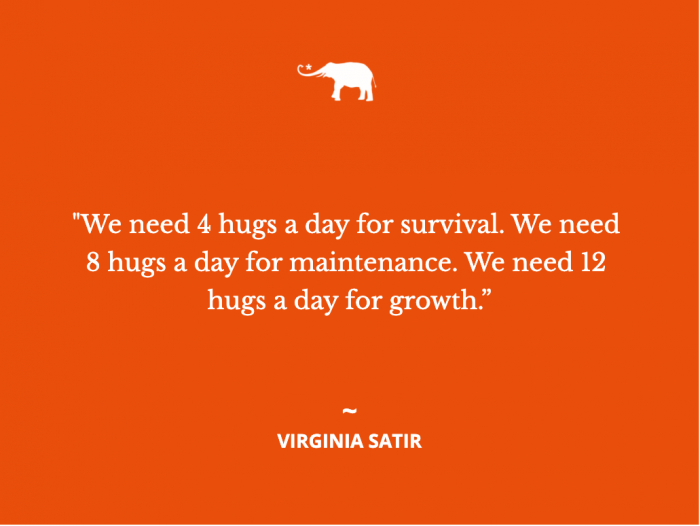Hugs matter, because just one hug from the right person can take all our stress away.
The power of a hug can have countless health benefits.
We hug others when we are excited, happy, sad, or when we are trying to comfort someone—hugging makes us feel so good.
The act of hugging makes us healthier and happier, they’re consoling during hard times too.
The healing process begins with a touch and embrace—it’s just that simple.
Why not start making hugging a regular part of your day?
Here are a few good reasons to hug someone:
Hugs reduce stress by showing support. When a friend or family member is dealing with something painful or unpleasant in their lives, give them a hug. Giving another person support through touch can reduce their stress and can even reduce the stress of the person doing the comforting.
Hugs may protect us against illnesses. The stress-reducing effects of hugging might also work to keep us healthier. Hugging may reduce the chance that a person will get sick.
Hugs can make us happier. Oxytocin is a chemical in our bodies that scientists sometimes call the “cuddle hormone.” This is because its levels rise when we hug, touch, or sit close to someone else. Oxytocin is associated with happiness and less stress. Oxytocin causes a reduction in blood pressure and of the stress hormone norepinephrine.
Hugs help reduce fears. Touch can reduce anxiety in people with low self-esteem. Touch can also keep people from isolating themselves when reminded of their mortality, especially when grieving.
Hugs may help reduce pain. Hugging is a form of touch that may be capable of reducing pain.
Hugs help us communicate with others. Most human communication occurs verbally or through facial expressions, but touch is another important way that people can send messages to one another. Some emotions expressed include anger, fear, disgust, love, gratitude, happiness, sadness, and sympathy. Hugging is a very comforting and communicative type of touch.
How many hugs do we need?
While that may sound like a lot of hugs, it seems that many hugs are better than not enough. We should have as many as possible if we want to reap the greatest positive effects. If you want to feel better about yourself, reduce your stress, improve communication, and be happier and healthier, it seems that giving and asking for more hugs is always a good place to start.
If you feel nervous about seeking out more hugs, start by asking for them from friends and family members closest to you first.
Hugging benefits the giver and receiver. It takes two or more to hug it out.
Often, we embrace or hold our children when they’re in need of comfort. But as it turns out, comforting hugs are little acts of love that may be beneficial for the receiver—but also for the giver. It is a two-way street.
How to Give a Good Hug:
>> Hug someone for at least 20 seconds.
>> Don’t be wimpy or weak about it—make it like a good bear hug to show how much you care.
>> Practice the “heart to heart” hug by raising your left arm up to wrap it over the upper right shoulder of your hugging partner, leaving your right arm lower in order to wrap around his or her midsection, just below his or her left arm.
Yet another reason to hug is the emotional uplift we receive leaving us with a lasting physical impact as well.
When we get that hit of oxytocin, the hormonal surge bonds with the person we are hugging. There is a transfer of positive energy from one human to the other and we feel safer and supported.
The best part of hugging is that it is a non-pharmacological, non-invasive, universal expression of love and care.
It’s the gift that gives back because we cannot hug someone without getting the same reaction we provide.
Both parties benefit from the emotional and physical giving and receiving of these healthy feelings.
Just a simple hug can be very powerful. It has the ability to reduce stress, cure sadness, and can heal our wounds.

No comments:
Post a Comment